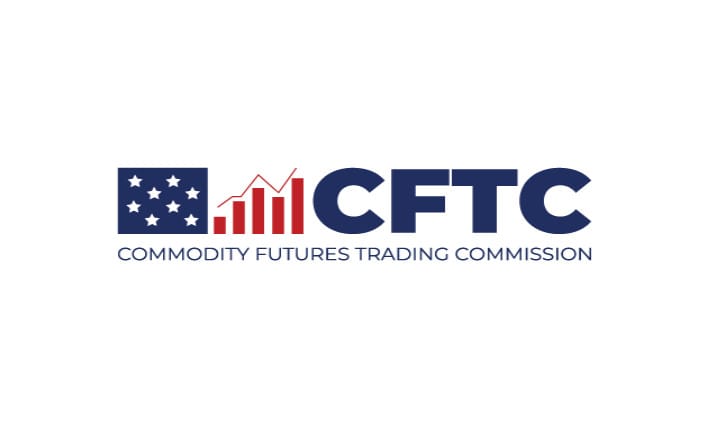NSCC Alert! SR-NSCC-2022-015 OPEN for comment: NSCC proposes to make changes to the gap risk charge. They state: 'Gap risk events have been generally understood as idiosyncratic issuer events that cause a rapid shift in price volatility levels.'
Source: https://public-inspection.federalregister.gov/2023-06059.pdf
SR-NSCC-2022-015: https://www.sec.gov/rules/sro/nscc/2022/34-96511.pdf
Comments are available at: https://www.sec.gov/comments/sr-nscc-2022-015/srnscc2022015.htm
Background:
- A key tool that NSCC uses to manage its respective credit exposures to its members is the daily collection of margin from each member, which is referred to as each member’s Required Fund Deposit.
- The aggregated amount of all members’ margin constitutes the Clearing Fund, which NSCC would access should a defaulted member’s own margin be insufficient to satisfy losses to NSCC caused by the liquidation of that member’s portfolio.
- Each member’s margin consists of a number of applicable components, each of which is calculated to address specific risks faced by NSCC.
- Generally, the largest portion of a member’s margin is the volatility component, often referred to as the VaR Charge, which is designed to reflect the amount of money that could be lost on a portfolio over a given period within a 99th percentile level of confidence.
- Under NSCC’s current rules, one of the potential methods of calculating the VaR Charge relies on a measure of gap risk.
- It does not accrue for all portfolios, but instead only serves as the VaR Charge if it is the largest of three potential calculations.
- The gap risk charge was designed to address the risk presented by a portfolio that is more susceptible to the effects of gap risk events, i.e., those portfolios holding positions that represent more than a certain percent of the entire portfolio’s value, such that the event could impact the entire portfolio’s value.
How this is calculated currently:
NSCC multiplies the gross market value of the largest non-index net unsettled position in the portfolio by a gap risk haircut, which can be no less than 10 percent (“gap risk haircut”).
- NSCC determines the gap risk haircut empirically as no less than the larger of the 1st and 99th percentiles of three day returns of a set of CUSIPs that are subject to the VaR Charge pursuant to the Rules, giving equal rank to each to determine which has the highest movement over that three day period.
- NSCC uses a look-back period of not less than ten years plus a one-year stress period, and if the one-year stress period overlaps with the look-back period, only the non-overlapping period would be combined with the look-back period.
- The resulting haircut is then rounded up to the nearest whole percentage and applied to the largest non-index net unsettled position to determine the gap risk charge.
What they want to do:
- Make the gap risk charge an additive component of the member’s total VaR Charge when it is applicable, rather than being applied as the applicable VaR Charge only when it is the largest of three separate calculations.
- Adjusting the gap risk charge to be based on the two largest positions in a portfolio, rather than based on the single largest position
- Changing the floor of the gap risk haircut from 10 percent to 5 percent for the largest position, adding a floor of the gap risk haircut of 2.5 percent for the second largest position, and providing that gap risk haircuts would be determined based on back testing and impact analysis
- Amending which ETF positions are excluded from the gap risk charge to more precisely include ETFs that are more prone to gap risk, i.e., are non-diversified.
Gap risk events have been generally understood as idiosyncratic issuer events that cause a rapid shift in price volatility levels:

Gap risk events have been generally understood as idiosyncratic issuer events (for example, earning reports, management changes, merger announcements, insolvency, or other unexpected, issuer-specific events) that cause a rapid shift in price volatility levels.

The gap risk charge was designed to address the risk presented by a portfolio that is more susceptible to the effects of gap risk events, i.e., those portfolios holding positions that represent more than a certain percent of the entire portfolio’s value, such that the event could impact the entire portfolio’s value.
I guess due to the idiosyncratic nature of the item called out above, that is why they are proposing to modify the gap risk charge? It is no longer meeting the purpose it was 'designed' for 'as-is'?
The Commission seeks and encourages interested persons to comment on the Proposed Rule Change:

The Commission is instituting proceedings to allow for additional analysis of, and input from commenters with respect to, the Proposed Rule Change’s consistency with Section 17A of the Act, and the rules, including the following provisions:
- Section 17A(b)(3)(F) of the Act, which requires, among other things, that the rules of a clearing agency must be designed to promote the prompt and accurate clearance and settlement of securities transactions, to assure the safeguarding of securities and funds which are in the custody or control of the clearing agency or for which it is responsible, and to protect investors and the public interest
- Rule 17Ad-22(e)(4)(i) of the Act, which requires that a covered clearing agency establish, implement, maintain, and enforce written policies and procedures reasonably designed to effectively identify, measure, monitor, and manage its credit exposures to participants and those arising from its payment, clearing, and settlement processes, including by maintaining sufficient financial resources to cover its credit exposure to each participant fully with a high degree of confidence.
- Rule 17Ad-22(e)(6)(i) of the Act, which requires that a covered clearing agency establish, implement, maintain, and enforce written policies and procedures reasonably designed to cover, if the covered clearing agency provides central counterparty services, its credit exposures to its participants by establishing a risk based margin system that, at a minimum, considers, and produces margin levels commensurate with, the risks and particular attributes of each relevant product, portfolio, and market.
Comments may be submitted by any of the following methods:
Electronic Comments:
- Send an e-mail to [email protected]. Please include File Number SRNSCC-2022-015 on the subject line.
- or https://www.sec.gov/rules/sro.shtml to look up (email is easier)
Paper Comments:
- Send paper comments in triplicate to Secretary, Securities and Exchange Commission, 100 F Street, NE, Washington, DC 20549-1090. All submissions should refer to File Number SR-NSCC-2022-015.
The Commission will post all comments on the Commission’s Internet website (http://www.sec.gov/rules/sro.shtml). Copies of the submission, all subsequent amendments, all written statements with respect to the Proposed Rule Change that are filed with the Commission, and all written communications relating to the Proposed Rule Change between the Commission and any person, other than those that may be withheld from the public in accordance with the provisions of 5 U.S.C. 552, will be available for website viewing and printing in the Commission’s Public Reference Room, 100 F Street, NE, Washington, DC 20549 on official business days between the hours of 10:00 a.m. and 3:00 p.m. Copies of the filing also will be available for inspection and copying at the principal office of NSCC and on DTCC’s website (http://dtcc.com/legal/sec-rulefilings.aspx).
All comments received will be posted without change. Persons submitting comments are cautioned that we do not redact or edit personal identifying information from comment submissions. You should submit only information that you wish to make available publicly.
Opinion:
At first blush, this could be construed as favorable for them?
Changing the floor of the gap risk haircut from 10 percent to 5 percent for the largest position
When currently: NSCC multiplies the gross market value of the largest non-index net unsettled position in the portfolio by a gap risk haircut, which can be no less than 10 percent
Adjusting the gap risk charge to be based on the two largest positions in a portfolio, rather than based on the single largest position
How is this done? If the Largest position is adjusted downward to 5% and the second position is collecting 2.5%, that is still 2.5% less collected then the 10% of the largest position initially? This is where numbers can get confusing and open to be corrected by those better at maths.
Amending which ETF positions are excluded from the gap risk charge to more precisely include ETFs that are more prone to gap risk, i.e., are non-diversified.
We are worried about ETF abuse now, right? allowing more the be excluded from the charge is probably not the best idea?
This seems like it could be favorable for retail?
Make the gap risk charge an additive component of the member’s total VaR Charge when it is applicable, rather than being applied as the applicable VaR Charge only when it is the largest of three separate calculations.
TLDRS:
NSCC proposes to modify Procedure XV (Clearing Fund Formula and Other Matters) of NSCC’s Rules & Procedures (“Rules”) to make changes to the gap risk charge.
'Gap risk events have been generally understood as idiosyncratic issuer events that cause a rapid shift in price volatility levels.'
The Commission seeks and encourages interested persons to comment on the Proposed Rule Change.



